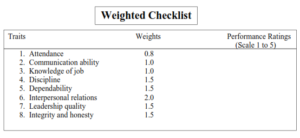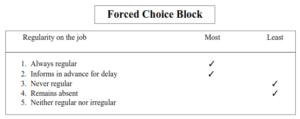iv. Paired Comparisons Method
- In this method one employee’s performance is compared with that of the other employees. Two employees are taken at a time and a decision is made on who is more competent. Then another pair is compared and the same process is repeated until all are compared and ranked.
- The number of times an employee is judged better than the other determines his
- Comparison is made on the basis of overall performance. The number of comparisons to be made can be decided on the basis of the following formula:
N(N-1)/2
Where N is the number of persons to be compared. The method is illustrated below:
|
A |
B | C | D | E | Final Rank | |
|
A |
– | – | – | + | + | 3 |
|
B |
+ | – | – | + | + | 2 |
|
C |
+ | + | – | + | + |
1 |
| D | – | – | – | – | + |
4 |
| E |
– |
– | – | – | – |
5 |
- Herein, plus (+) sign implies the employee is considered better and minus (-) sign means worse than the other employee in the C gets the highest number of plus signs, therefore, his rank is the highest and so on.
- It is not suitable for large organizations as it becomes very cumbersome to compare large number of employees.
v. Forced Distribution Method
- In this technique, the rater is required to distribute his ratings in the form of a normal frequency distribution.
- The purpose is to eliminate the rater’s bias of central
- Appraisers have to choose from among groups of statements those which best describes the employee and those which least describes him.
- The statements are then weighted or scored. People with high scores are the better employees those with low scores are the marginal ones.
- Since rater does not know what the scoring weights for each statements are , he cannot play favourites.
vi. Graphic Rating Scales
- Typically, a graphic scale assesses an employee on a rating scale comprising lists of traits and a range of performance values for each trait.
- Rating scale can be continuous, where degree of traits are measured in numbers say (1,2,3 and 4) scale and/or discontinuous say outstanding, above average, average or unsatisfactory.
- The approach is multi-dimensional as several significant dimensions of the job can be considered in evaluation.
- In practice, ratings tend to cluster on the high side. A supervisor often tends to rate his subordinates high to avoid criticism from them. To minimize this bias, the rater may be asked to give reasons to justify his rating.
vii. Checklist Method
- A checklist is a list of statements that describe the characteristics and performance of employees on the job.
- The rater checks to indicated if the behavior of an employee is positive or negative to each statement.
- There are three types of checklists that can be used:
a) Simple Checklist – equal importance is given to each statement.
b) Weighted Checklist – weights are assigned to different statements.
c) Forced Choice Checklist – five statements are given for each trait.





hi I want the notes for HRM for ugc net exam
Please visit Entrance Exam Section on our website. We have uploaded notes and MCQS on HRM for first three units.Soon will be uploading rest of the units.